Emissary Orion's Report
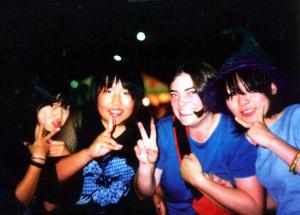 December 27th-31st
December 27th-31st
I came down from remote Hokkaido to visit Osaka for the first time. Among us English teachers, it`s a known fact that none of our Japanese acquaintances want to talk about anything resembling social unrest, so I was operating in a vacuum. And there are very few homeless people in Hokkaido, probably because they would freeze to death in our two annual meters of snow. But I knew they must be somewhere. Coming south to Osaka, one of Japan`s biggest cities, I saw not only where Japan`s disenfranchised end up, but also some of the kick-ass grassroots organizing they`re attempting, and this in the face of the massive Japanese-societal distaste for rocking the boat.
I reached Osaka on the 27th, after a 30-hour-long ferry ride, the first leg during a big storm off the Hokkaido coast. For days after, whenever I laid still, my body seemed to rock. Arriving in Osaka, I navigated the bewilderingly huge train station and met two filmmaker friends of mine from Portland, Oregon, who had swung a ticket through Japan for a few days of filming in Osaka`s homeless villages. As a supporter of Dignity Village (a Portland`s tented community), I have been reading emails from a Japanese comrade called Rebel Jill for over a year now, a homeless activist in Osaka, Kansai region; now was my chance to meet him. My friends were eager to complement their documentary-in-progress on Dignity Village with footage from its "Sister City" in Japan, an incredible opportunity, to say the least.
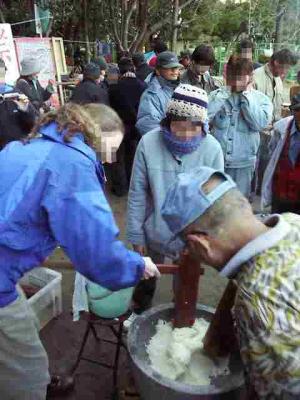 When we arrived at Nagai Koen, a large park boasting an Olympic stadium, we walked until we saw the village of blue-tarped tents, looking a lot like Dignity in its adolescence. Perhaps expecting some depressing scene, I was instead rather startled to see that some sort of party was in progress, with lots of hollering and mingling. The Nagai Park Villagers and their supporters and friends were celebrating the holiday season in the most time-honored fashion, though in the most unlikely of settings: here, off the park road, by a bonfire in a barrel, they were taking turns heartily pounding mochi in a giant mortar, to the rhythmic cries of "YOSH!" (Japanese families traditionally use big wooden mallets to pound the harvest`s rice into mochi, a kind of chewy rice paste shaped into sweets and eaten in stews.) Upon being warmly welcomed and asked to give a brief speech of solidarity, we tried our hand at mochi-pounding, and begin to talk to the many residents and supporters attending.
When we arrived at Nagai Koen, a large park boasting an Olympic stadium, we walked until we saw the village of blue-tarped tents, looking a lot like Dignity in its adolescence. Perhaps expecting some depressing scene, I was instead rather startled to see that some sort of party was in progress, with lots of hollering and mingling. The Nagai Park Villagers and their supporters and friends were celebrating the holiday season in the most time-honored fashion, though in the most unlikely of settings: here, off the park road, by a bonfire in a barrel, they were taking turns heartily pounding mochi in a giant mortar, to the rhythmic cries of "YOSH!" (Japanese families traditionally use big wooden mallets to pound the harvest`s rice into mochi, a kind of chewy rice paste shaped into sweets and eaten in stews.) Upon being warmly welcomed and asked to give a brief speech of solidarity, we tried our hand at mochi-pounding, and begin to talk to the many residents and supporters attending.
 As people thrust oranges and delicious camp-stove-made takoyaki and other Osaka delicacies on us, we started to do some interviews, I with my minidisk recorder for eventual KBOO radio broadcast, they with their video camera. The Nagai Village Mochi Festival, we were soon told, was conceived as a way to build community with the Village`s neighbors, supporters, and surrounding homeless people. Village Elder and Camp Cook Tabata-san told us about how many Villagers work at a local vegetable farm, selling what they grow in Nagai Koen; he couldn`t show us a sample, as they had sold out that day. Two other gentlemen told us about the circumstances precipitating their homelessness. Both had been laid off from big companies they had worked at for years; one had been discarded by his wife as the result. As my Japanese is rudimentary, at best, some activist college students and a Professor from a local University rose to the "English challenge" and graciously collaborated to translate for us.
As people thrust oranges and delicious camp-stove-made takoyaki and other Osaka delicacies on us, we started to do some interviews, I with my minidisk recorder for eventual KBOO radio broadcast, they with their video camera. The Nagai Village Mochi Festival, we were soon told, was conceived as a way to build community with the Village`s neighbors, supporters, and surrounding homeless people. Village Elder and Camp Cook Tabata-san told us about how many Villagers work at a local vegetable farm, selling what they grow in Nagai Koen; he couldn`t show us a sample, as they had sold out that day. Two other gentlemen told us about the circumstances precipitating their homelessness. Both had been laid off from big companies they had worked at for years; one had been discarded by his wife as the result. As my Japanese is rudimentary, at best, some activist college students and a Professor from a local University rose to the "English challenge" and graciously collaborated to translate for us.
I was amazed to see so many activists and supporters at the Village! In my home-suburb of Sapporo, when I ask people where the homeless are, and who helps support them, I am always met with blank stares. I had never met anyone even approximating what I would call "activist," and most people weren`t willing to even discuss issues like poverty and homelessness (the ostrich tactic being very, very popular in Japan). But here at Nagai Koen, I met a young Japanese man who had gone to Iraq as a human shield; I met young people that had dropped out of college to join the struggle from within the villages. There was a whole world that reminded me so much of the energy and drive of Portland`s activist community, that I felt high with delight. I was deeply touched by the Village`s ability to see past their troubles and share in this ancient harvest festival with the rest of housed Japan.
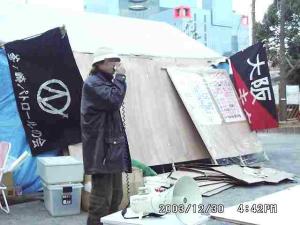 Over the next five days, with homeless activists and supporters as my guides, I saw the side of Japan I had been seeking, the side that Japanese want to tell you doesn`t exist. All those thousands of laid-off salary-men we read about go somewhere; all those victims of Japan`s alcohol culture; all those causalities of the most expensive housing market in the world. It turns out, Osaka is Japan`s largest temporary labor market, with tens of thousands of workers converging from all over the country to try their luck at Kamagasaki, a district of Osaka where companies also converge, to legally or illegally hire on workers for temporary jobs needing filled all over Japan. As the result, Osaka is full of shanty towns, large and small, organized by their residents to greater or lesser degrees, harassed by the police to greater or lesser degrees.
Over the next five days, with homeless activists and supporters as my guides, I saw the side of Japan I had been seeking, the side that Japanese want to tell you doesn`t exist. All those thousands of laid-off salary-men we read about go somewhere; all those victims of Japan`s alcohol culture; all those causalities of the most expensive housing market in the world. It turns out, Osaka is Japan`s largest temporary labor market, with tens of thousands of workers converging from all over the country to try their luck at Kamagasaki, a district of Osaka where companies also converge, to legally or illegally hire on workers for temporary jobs needing filled all over Japan. As the result, Osaka is full of shanty towns, large and small, organized by their residents to greater or lesser degrees, harassed by the police to greater or lesser degrees.
In Kamagasaki, right in down-town Osaka, there is a huge black/ market, winding its way through the narrow streets of the neighborhood, lined with flop houses, cheap noodle joints, and the occasional social service. Tucked into this pre-LeCoubusier-France jumble of windy streets are entire homeless communities, some of which have been there for years. In one main camp, men paused in their bustling bicycle-repair camp-businesses to watch us gaijin women take photos, and camp dogs ambled over to get pets. Some camps had chickens, some were clearly homes, complete with potted plants and artwork. One camp resident, wary at first, had soon appointed himself as our tour guide, and brought us to his favorite local social service, wrangling us an interview and tour from the nervous clinic Director. The clinic provided several dozen tidy shelter beds for sick people with no housing or medical cards.
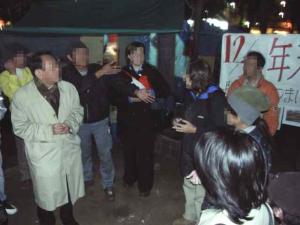 We saw, in several locations (Nishinari Koen, Osaka-Jo Koen) that the City of Osaka was pursuing an odd policy of bulldozing into areas of tented encampments and building shelters, as a way to encourage the camps to clean out. We took a tour of one such shelter, which looked nice from the outside, and had clean communal bathrooms and cooking areas; but inside we found that the tidy beds were lined up in cubbies literally not much more than the size of the bed, barely enough room to walk on one side of it to get in. When I asked the manager with barely masked incredulity if maybe he thought the living space was a little small, he said, "Oh, Japanese people are small, they don`t need much room!" Outside, back in the tented community filled with communal cooking, chickens, dogs, cats, husbands and wives, and makeshift houses decorated with art, patios, and porches, I had to admit that there was no way I could be induced to leave such a place for a sterile cubby.
We saw, in several locations (Nishinari Koen, Osaka-Jo Koen) that the City of Osaka was pursuing an odd policy of bulldozing into areas of tented encampments and building shelters, as a way to encourage the camps to clean out. We took a tour of one such shelter, which looked nice from the outside, and had clean communal bathrooms and cooking areas; but inside we found that the tidy beds were lined up in cubbies literally not much more than the size of the bed, barely enough room to walk on one side of it to get in. When I asked the manager with barely masked incredulity if maybe he thought the living space was a little small, he said, "Oh, Japanese people are small, they don`t need much room!" Outside, back in the tented community filled with communal cooking, chickens, dogs, cats, husbands and wives, and makeshift houses decorated with art, patios, and porches, I had to admit that there was no way I could be induced to leave such a place for a sterile cubby.
 The homeless of Kamagasaki are not just waiting for social services, though. The Kamagasaki Patrol and the Poor People`s Association of Nagai Park assert their right to form communities together on unused land, as an alternative to the streets or shelters. Their leadership comes from within. At night, the Patrol took us on a foot patrol of the wider area, doing outreach to isolated campers, asking them about incidences of harassment, assessing their needs, giving them information about activist-organized events coming up, as well as shelter information. When we came to fences and prohibitive signs erected in parks where sweeps of the homeless had recently been conducted, they kicked them down, my hitherto-gentle comrades expressing a quietly angry vigor that surprised me. The students and comrades then bundled up the wooden stakes, with that exaggerated Japanese care, and gave them to the villagers for firewood. I was amazed at how organized these activists were.
The homeless of Kamagasaki are not just waiting for social services, though. The Kamagasaki Patrol and the Poor People`s Association of Nagai Park assert their right to form communities together on unused land, as an alternative to the streets or shelters. Their leadership comes from within. At night, the Patrol took us on a foot patrol of the wider area, doing outreach to isolated campers, asking them about incidences of harassment, assessing their needs, giving them information about activist-organized events coming up, as well as shelter information. When we came to fences and prohibitive signs erected in parks where sweeps of the homeless had recently been conducted, they kicked them down, my hitherto-gentle comrades expressing a quietly angry vigor that surprised me. The students and comrades then bundled up the wooden stakes, with that exaggerated Japanese care, and gave them to the villagers for firewood. I was amazed at how organized these activists were.
The Kamagasaki Patrol`s nightly foot patrols were just part of a multi-day series of events they had organized over the New Year`s holiday season that were advertised through fliers and outreach well in advance, and were extensions of their regular patrols they had been doing for years. In between carefully executed events that would put my Board of Education to shame, Patrol members, usually homeless, led us on a very organized tour of the "underbelly" of Osaka, with the help of K, a dedicated supporters who translated.
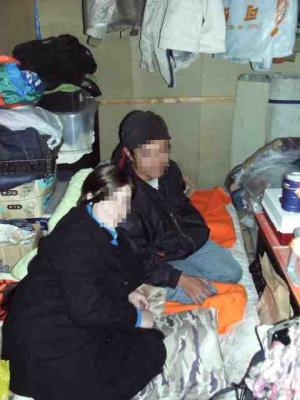 We saw the vast, third-world-looking concrete warehouse where laborers go to pick up piece-work from corrupt subcontractors sanctioned by the government, who take a substantial cut of their pay. Other men, too sick to work, merely laid on blankets and cardboard in the echoing multi-storied icy vault. I have never seen anything like it, but then, I`ve not yet been to the Third World; "See The Third World Without Leaving Japan!" We went to the site of a shelter-bed "giveaway," beds provided by the City for the week over New Year`s, when companies shut down, and laborers have no pay. Men tiredly trudged from one location, to another, to another, collecting scraps of paper and numbers that would perhaps eventually result in a shelter bed. While I slept in a tent graciously provided by Nagai Village, the Kamagasaki Patrol had been up since 5 am that morning, hunting down men to give line-place-holders to, guiding them to the first hoop.
We saw the vast, third-world-looking concrete warehouse where laborers go to pick up piece-work from corrupt subcontractors sanctioned by the government, who take a substantial cut of their pay. Other men, too sick to work, merely laid on blankets and cardboard in the echoing multi-storied icy vault. I have never seen anything like it, but then, I`ve not yet been to the Third World; "See The Third World Without Leaving Japan!" We went to the site of a shelter-bed "giveaway," beds provided by the City for the week over New Year`s, when companies shut down, and laborers have no pay. Men tiredly trudged from one location, to another, to another, collecting scraps of paper and numbers that would perhaps eventually result in a shelter bed. While I slept in a tent graciously provided by Nagai Village, the Kamagasaki Patrol had been up since 5 am that morning, hunting down men to give line-place-holders to, guiding them to the first hoop.
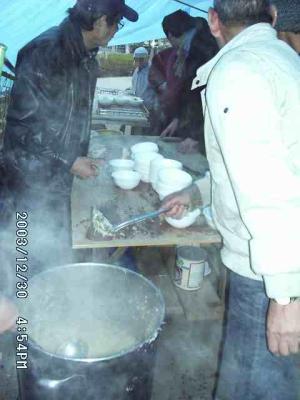 I learned from the hard-core, crusty old labor activists there that many of the sub-contracting companies that flock to Osaka have gained notoriety for not paying their workers, especially picking on the oldest workers as targets least likely to complain. In recent years it has become something of a scandal, and some of the trade unions are demanding that the companies be held responsible. They say there are even incidences of workers being killed when they have demanded their back pay, itinerant workers they figure no one will miss. One night I participated in a protest march following a Winter Struggle Festival held to bolster the Kamagasaki people through the frigid Osaka holidays. After the last act had left the stage and the soup kitchen was closed, the somewhat rowdy crowd, flanked by Communist Party flag marshals, weaved through the park`s burning barrels and filed past silent lines of police with riot shields. The crowd shouted what, I was told by my comrades, was a
traditional Japanese labor-rights cry: "WASSHOI!" The police dogged us in riot formation, but without full riot gear, and mostly without comment, as we moved down the street. They even led the march with police lanterns on poles. At about 100, they had us slightly outnumbered. I learned that this rally had been held every year for the past 36 years! No wonder the police looked tense, but relatively calm. I wish the Portland police would come take some lessons in how to deal with non-violent protest. Our feet aching and shoulders weighted with backpacks, we left before it was finished, veering off towards the subway.
I learned from the hard-core, crusty old labor activists there that many of the sub-contracting companies that flock to Osaka have gained notoriety for not paying their workers, especially picking on the oldest workers as targets least likely to complain. In recent years it has become something of a scandal, and some of the trade unions are demanding that the companies be held responsible. They say there are even incidences of workers being killed when they have demanded their back pay, itinerant workers they figure no one will miss. One night I participated in a protest march following a Winter Struggle Festival held to bolster the Kamagasaki people through the frigid Osaka holidays. After the last act had left the stage and the soup kitchen was closed, the somewhat rowdy crowd, flanked by Communist Party flag marshals, weaved through the park`s burning barrels and filed past silent lines of police with riot shields. The crowd shouted what, I was told by my comrades, was a
traditional Japanese labor-rights cry: "WASSHOI!" The police dogged us in riot formation, but without full riot gear, and mostly without comment, as we moved down the street. They even led the march with police lanterns on poles. At about 100, they had us slightly outnumbered. I learned that this rally had been held every year for the past 36 years! No wonder the police looked tense, but relatively calm. I wish the Portland police would come take some lessons in how to deal with non-violent protest. Our feet aching and shoulders weighted with backpacks, we left before it was finished, veering off towards the subway.
Over the days, we spoke at homeless-organized rallies and soup kitchens, offering encouraging words of international solidarity: "Our struggle is your struggle. Poor workers in America and Japan and elsewhere have more in common with each other than with the bosses of those countries. We are facing the same battles." Everywhere we went, K, the incredible young Japanese activist from Kyoto, translated everything for us. My main guide through everything was Rebel Jill, a homeless comrade, and a core organizer of the Poor People`s Association of Nagai Park and of Kamagasaki Patrol. Rebel Jill is a remarkable man, razor-sharp, incredibly committed, indefatigable, but shy. He is a true community organizer, always nudging others before him into positions of leadership. Rebel Jill and Shintaro, another young activist, helped translate and navigated the subway and train systems for us, the back-alleys and hidden parks where people eked out communities. They taught us Osaka-ben
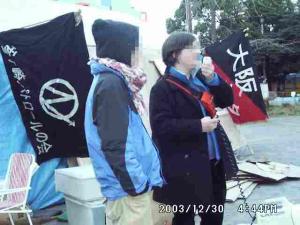 (dialect), Osaka culture, Osaka humor. Nagai Village and Ougimachi Village housed K and I every night, the villagers sharing their hot food and coffee and sheltering us in tents and mounds of fluffy futons, sometimes insisting on giving up their beds. K was sick the whole time and ran a fever, but never complained. The villgers cooked us feasts, told us stories, asked about America, and we went to the onsen, the Japanese baths, together. They made me feel human; after months of isolation in Hokkaido, I was in the thick of real life again. I felt that their energy, and passion, and purpose infused my every cell.
(dialect), Osaka culture, Osaka humor. Nagai Village and Ougimachi Village housed K and I every night, the villagers sharing their hot food and coffee and sheltering us in tents and mounds of fluffy futons, sometimes insisting on giving up their beds. K was sick the whole time and ran a fever, but never complained. The villgers cooked us feasts, told us stories, asked about America, and we went to the onsen, the Japanese baths, together. They made me feel human; after months of isolation in Hokkaido, I was in the thick of real life again. I felt that their energy, and passion, and purpose infused my every cell.
I am now plotting how to spend all the time I can in Osaka, during my remaining time in Japan, to see Jill and the other comrades, and observe/ support their incredible work in the different Osaka villages and the Kamagasaki Patrol. This experience has revolutionized my time in Japan. I recommend a trip to Osaka for any organizer who may find themselves in Japan, or in Asia, for that matter.
For an earlier report on tent cities in Japan click
here.
 When we arrived at Nagai Koen, a large park boasting an Olympic stadium, we walked until we saw the village of blue-tarped tents, looking a lot like Dignity in its adolescence. Perhaps expecting some depressing scene, I was instead rather startled to see that some sort of party was in progress, with lots of hollering and mingling. The Nagai Park Villagers and their supporters and friends were celebrating the holiday season in the most time-honored fashion, though in the most unlikely of settings: here, off the park road, by a bonfire in a barrel, they were taking turns heartily pounding mochi in a giant mortar, to the rhythmic cries of "YOSH!" (Japanese families traditionally use big wooden mallets to pound the harvest`s rice into mochi, a kind of chewy rice paste shaped into sweets and eaten in stews.) Upon being warmly welcomed and asked to give a brief speech of solidarity, we tried our hand at mochi-pounding, and begin to talk to the many residents and supporters attending.
When we arrived at Nagai Koen, a large park boasting an Olympic stadium, we walked until we saw the village of blue-tarped tents, looking a lot like Dignity in its adolescence. Perhaps expecting some depressing scene, I was instead rather startled to see that some sort of party was in progress, with lots of hollering and mingling. The Nagai Park Villagers and their supporters and friends were celebrating the holiday season in the most time-honored fashion, though in the most unlikely of settings: here, off the park road, by a bonfire in a barrel, they were taking turns heartily pounding mochi in a giant mortar, to the rhythmic cries of "YOSH!" (Japanese families traditionally use big wooden mallets to pound the harvest`s rice into mochi, a kind of chewy rice paste shaped into sweets and eaten in stews.) Upon being warmly welcomed and asked to give a brief speech of solidarity, we tried our hand at mochi-pounding, and begin to talk to the many residents and supporters attending.
 December 27th-31st
December 27th-31st As people thrust oranges and delicious camp-stove-made takoyaki and other Osaka delicacies on us, we started to do some interviews, I with my minidisk recorder for eventual KBOO radio broadcast, they with their video camera. The Nagai Village Mochi Festival, we were soon told, was conceived as a way to build community with the Village`s neighbors, supporters, and surrounding homeless people. Village Elder and Camp Cook Tabata-san told us about how many Villagers work at a local vegetable farm, selling what they grow in Nagai Koen; he couldn`t show us a sample, as they had sold out that day. Two other gentlemen told us about the circumstances precipitating their homelessness. Both had been laid off from big companies they had worked at for years; one had been discarded by his wife as the result. As my Japanese is rudimentary, at best, some activist college students and a Professor from a local University rose to the "English challenge" and graciously collaborated to translate for us.
As people thrust oranges and delicious camp-stove-made takoyaki and other Osaka delicacies on us, we started to do some interviews, I with my minidisk recorder for eventual KBOO radio broadcast, they with their video camera. The Nagai Village Mochi Festival, we were soon told, was conceived as a way to build community with the Village`s neighbors, supporters, and surrounding homeless people. Village Elder and Camp Cook Tabata-san told us about how many Villagers work at a local vegetable farm, selling what they grow in Nagai Koen; he couldn`t show us a sample, as they had sold out that day. Two other gentlemen told us about the circumstances precipitating their homelessness. Both had been laid off from big companies they had worked at for years; one had been discarded by his wife as the result. As my Japanese is rudimentary, at best, some activist college students and a Professor from a local University rose to the "English challenge" and graciously collaborated to translate for us.
 Over the next five days, with homeless activists and supporters as my guides, I saw the side of Japan I had been seeking, the side that Japanese want to tell you doesn`t exist. All those thousands of laid-off salary-men we read about go somewhere; all those victims of Japan`s alcohol culture; all those causalities of the most expensive housing market in the world. It turns out, Osaka is Japan`s largest temporary labor market, with tens of thousands of workers converging from all over the country to try their luck at Kamagasaki, a district of Osaka where companies also converge, to legally or illegally hire on workers for temporary jobs needing filled all over Japan. As the result, Osaka is full of shanty towns, large and small, organized by their residents to greater or lesser degrees, harassed by the police to greater or lesser degrees.
Over the next five days, with homeless activists and supporters as my guides, I saw the side of Japan I had been seeking, the side that Japanese want to tell you doesn`t exist. All those thousands of laid-off salary-men we read about go somewhere; all those victims of Japan`s alcohol culture; all those causalities of the most expensive housing market in the world. It turns out, Osaka is Japan`s largest temporary labor market, with tens of thousands of workers converging from all over the country to try their luck at Kamagasaki, a district of Osaka where companies also converge, to legally or illegally hire on workers for temporary jobs needing filled all over Japan. As the result, Osaka is full of shanty towns, large and small, organized by their residents to greater or lesser degrees, harassed by the police to greater or lesser degrees.
 We saw, in several locations (Nishinari Koen, Osaka-Jo Koen) that the City of Osaka was pursuing an odd policy of bulldozing into areas of tented encampments and building shelters, as a way to encourage the camps to clean out. We took a tour of one such shelter, which looked nice from the outside, and had clean communal bathrooms and cooking areas; but inside we found that the tidy beds were lined up in cubbies literally not much more than the size of the bed, barely enough room to walk on one side of it to get in. When I asked the manager with barely masked incredulity if maybe he thought the living space was a little small, he said, "Oh, Japanese people are small, they don`t need much room!" Outside, back in the tented community filled with communal cooking, chickens, dogs, cats, husbands and wives, and makeshift houses decorated with art, patios, and porches, I had to admit that there was no way I could be induced to leave such a place for a sterile cubby.
We saw, in several locations (Nishinari Koen, Osaka-Jo Koen) that the City of Osaka was pursuing an odd policy of bulldozing into areas of tented encampments and building shelters, as a way to encourage the camps to clean out. We took a tour of one such shelter, which looked nice from the outside, and had clean communal bathrooms and cooking areas; but inside we found that the tidy beds were lined up in cubbies literally not much more than the size of the bed, barely enough room to walk on one side of it to get in. When I asked the manager with barely masked incredulity if maybe he thought the living space was a little small, he said, "Oh, Japanese people are small, they don`t need much room!" Outside, back in the tented community filled with communal cooking, chickens, dogs, cats, husbands and wives, and makeshift houses decorated with art, patios, and porches, I had to admit that there was no way I could be induced to leave such a place for a sterile cubby.
 The homeless of Kamagasaki are not just waiting for social services, though. The Kamagasaki Patrol and the Poor People`s Association of Nagai Park assert their right to form communities together on unused land, as an alternative to the streets or shelters. Their leadership comes from within. At night, the Patrol took us on a foot patrol of the wider area, doing outreach to isolated campers, asking them about incidences of harassment, assessing their needs, giving them information about activist-organized events coming up, as well as shelter information. When we came to fences and prohibitive signs erected in parks where sweeps of the homeless had recently been conducted, they kicked them down, my hitherto-gentle comrades expressing a quietly angry vigor that surprised me. The students and comrades then bundled up the wooden stakes, with that exaggerated Japanese care, and gave them to the villagers for firewood. I was amazed at how organized these activists were.
The homeless of Kamagasaki are not just waiting for social services, though. The Kamagasaki Patrol and the Poor People`s Association of Nagai Park assert their right to form communities together on unused land, as an alternative to the streets or shelters. Their leadership comes from within. At night, the Patrol took us on a foot patrol of the wider area, doing outreach to isolated campers, asking them about incidences of harassment, assessing their needs, giving them information about activist-organized events coming up, as well as shelter information. When we came to fences and prohibitive signs erected in parks where sweeps of the homeless had recently been conducted, they kicked them down, my hitherto-gentle comrades expressing a quietly angry vigor that surprised me. The students and comrades then bundled up the wooden stakes, with that exaggerated Japanese care, and gave them to the villagers for firewood. I was amazed at how organized these activists were.
 We saw the vast, third-world-looking concrete warehouse where laborers go to pick up piece-work from corrupt subcontractors sanctioned by the government, who take a substantial cut of their pay. Other men, too sick to work, merely laid on blankets and cardboard in the echoing multi-storied icy vault. I have never seen anything like it, but then, I`ve not yet been to the Third World; "See The Third World Without Leaving Japan!" We went to the site of a shelter-bed "giveaway," beds provided by the City for the week over New Year`s, when companies shut down, and laborers have no pay. Men tiredly trudged from one location, to another, to another, collecting scraps of paper and numbers that would perhaps eventually result in a shelter bed. While I slept in a tent graciously provided by Nagai Village, the Kamagasaki Patrol had been up since 5 am that morning, hunting down men to give line-place-holders to, guiding them to the first hoop.
We saw the vast, third-world-looking concrete warehouse where laborers go to pick up piece-work from corrupt subcontractors sanctioned by the government, who take a substantial cut of their pay. Other men, too sick to work, merely laid on blankets and cardboard in the echoing multi-storied icy vault. I have never seen anything like it, but then, I`ve not yet been to the Third World; "See The Third World Without Leaving Japan!" We went to the site of a shelter-bed "giveaway," beds provided by the City for the week over New Year`s, when companies shut down, and laborers have no pay. Men tiredly trudged from one location, to another, to another, collecting scraps of paper and numbers that would perhaps eventually result in a shelter bed. While I slept in a tent graciously provided by Nagai Village, the Kamagasaki Patrol had been up since 5 am that morning, hunting down men to give line-place-holders to, guiding them to the first hoop.
 I learned from the hard-core, crusty old labor activists there that many of the sub-contracting companies that flock to Osaka have gained notoriety for not paying their workers, especially picking on the oldest workers as targets least likely to complain. In recent years it has become something of a scandal, and some of the trade unions are demanding that the companies be held responsible. They say there are even incidences of workers being killed when they have demanded their back pay, itinerant workers they figure no one will miss. One night I participated in a protest march following a Winter Struggle Festival held to bolster the Kamagasaki people through the frigid Osaka holidays. After the last act had left the stage and the soup kitchen was closed, the somewhat rowdy crowd, flanked by Communist Party flag marshals, weaved through the park`s burning barrels and filed past silent lines of police with riot shields. The crowd shouted what, I was told by my comrades, was a
traditional Japanese labor-rights cry: "WASSHOI!" The police dogged us in riot formation, but without full riot gear, and mostly without comment, as we moved down the street. They even led the march with police lanterns on poles. At about 100, they had us slightly outnumbered. I learned that this rally had been held every year for the past 36 years! No wonder the police looked tense, but relatively calm. I wish the Portland police would come take some lessons in how to deal with non-violent protest. Our feet aching and shoulders weighted with backpacks, we left before it was finished, veering off towards the subway.
I learned from the hard-core, crusty old labor activists there that many of the sub-contracting companies that flock to Osaka have gained notoriety for not paying their workers, especially picking on the oldest workers as targets least likely to complain. In recent years it has become something of a scandal, and some of the trade unions are demanding that the companies be held responsible. They say there are even incidences of workers being killed when they have demanded their back pay, itinerant workers they figure no one will miss. One night I participated in a protest march following a Winter Struggle Festival held to bolster the Kamagasaki people through the frigid Osaka holidays. After the last act had left the stage and the soup kitchen was closed, the somewhat rowdy crowd, flanked by Communist Party flag marshals, weaved through the park`s burning barrels and filed past silent lines of police with riot shields. The crowd shouted what, I was told by my comrades, was a
traditional Japanese labor-rights cry: "WASSHOI!" The police dogged us in riot formation, but without full riot gear, and mostly without comment, as we moved down the street. They even led the march with police lanterns on poles. At about 100, they had us slightly outnumbered. I learned that this rally had been held every year for the past 36 years! No wonder the police looked tense, but relatively calm. I wish the Portland police would come take some lessons in how to deal with non-violent protest. Our feet aching and shoulders weighted with backpacks, we left before it was finished, veering off towards the subway.
 (dialect), Osaka culture, Osaka humor. Nagai Village and Ougimachi Village housed K and I every night, the villagers sharing their hot food and coffee and sheltering us in tents and mounds of fluffy futons, sometimes insisting on giving up their beds. K was sick the whole time and ran a fever, but never complained. The villgers cooked us feasts, told us stories, asked about America, and we went to the onsen, the Japanese baths, together. They made me feel human; after months of isolation in Hokkaido, I was in the thick of real life again. I felt that their energy, and passion, and purpose infused my every cell.
(dialect), Osaka culture, Osaka humor. Nagai Village and Ougimachi Village housed K and I every night, the villagers sharing their hot food and coffee and sheltering us in tents and mounds of fluffy futons, sometimes insisting on giving up their beds. K was sick the whole time and ran a fever, but never complained. The villgers cooked us feasts, told us stories, asked about America, and we went to the onsen, the Japanese baths, together. They made me feel human; after months of isolation in Hokkaido, I was in the thick of real life again. I felt that their energy, and passion, and purpose infused my every cell.